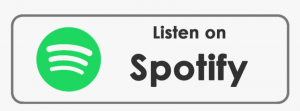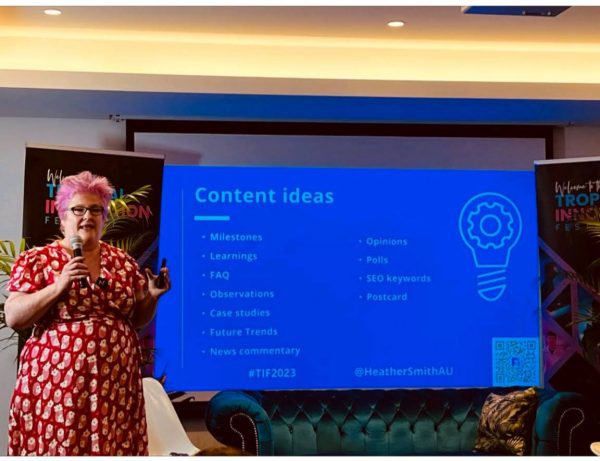“There’s an oversaturation of average content out there at the moment. But what we want to read is human-led content. Because it will be authentic and it will resonate. It can be short. It can be long. It’s that human-led raw, authentic content that will connect you with your brand and with your community.”
– Heather Smith, Founder at Anise Consulting.

In this episode, I’m sharing my talk on Content Creation for Building Your Brand at the Tropical Innovation Festival in Cairns in May ’23.
I talk about:
- Robot vs. human-led content.
- How to leverage ChatGPT and other tools in your content creation process.
- Questions are a gift, how to leverage them in your content.
- Recycle, Reuse and Repurpose content
- Being clear on the brand and image you want to present to the world.
- It’s also brimming with practical examples.
Tools mentioned in the talk included
– Canva for creating visual content
– Otter AI for transcribing audio recordings
– Google Docs and Microsoft Word for voice transcription features
– Grammarly and Hemingway app for proofreading
– ChatGPT for generating content ideas and outlines
– Loom for recording videos and conversations
– MailChimp for newsletters
A summary of the talk:
- How to tighten your content muscles
- Building a brand and building a community, and how to get that content muscle going.
- Get some content generated and get that muscle going.
- Robots vs. human-led content.
- ChatGPT is a phenomenal tool for generating content but human-led authentic content is best.
- What do you want to write about?
- Hemingway is a fun app if you’ve never played with it, and proofreading is important.
- Mailchimp is a newsletter and can be used as a blog post, podcast, transcript, summary, etc., and repurposed in different spaces.
- Questions are a gift to your community.
- Have recording equipment nearby. Rode mics or a voice recorder on your telephone.
- Recycle and repurpose content.
- Don’t send an email with eight different colours in it. Choose your colour palette and stick with it. Go to a paint store.
- Be clear on what your voice is.
This presentation was created in Canva, a great Australian company.
Starting off, there is a competition. I have chocolate, I have chocolate, all you need to do is get that content muscle going and grab your phone. Okay, it’s like yes. Okay, so Kate wants me to tell you about hashtag TIFF 2023. Create something while we’re talking today. You can tag me in it if you want. And the QR code. If you tag that, you can get a copy of all of my slides because I’m going to go through this quickly. But I want you to say what I learned, how it will use it to influence, impact, and reach my community, okay. Put it wherever you want, but I just want you to get some content generated and get that muscle going.
So today, can you see this thing I have on my dress? It is a RODE microphone. Okay. So my RODE microphone. At the end of the session, I will take it off, I’ll download the audio. I’ll put it into Otter.Ai. From Otter.AI, it will transcribe it. It will do an AI robot generated transcription. But it will also do a bullet point summary of my talk. From there, I may play in Google Docs which has great AI features for topping and tailing content, or proofreading content. Or I might put it in ChatGPT and make it very nice. From there, I will put it on all of the social medias. But I’ll also put it out through my podcast. Okay, so this one activity will potentially reach thousands of people, will potentially impact thousands of people. Okay, so I’m talking about content generation. There’s lots of different ways to do it.
So, I am an accountant. I’m not a marketing specialist. I’m not a branding specialist. I’m just telling you how I’m doing it. I love talking about, I love being an accountant. I love talking about accounting technology. Okay. I’ve written books, I’ve written 10 books, I write those really big, thick books that you find in the real bookstores. I can average about 20,000 words a month. And that’s an example of some of the books I’ve written. This is just kind of to prove that I’ve written content. I’m also extraordinarily grateful to be an opinion columnist for my local magazine or the local Australian magazine, Accounting Magazine. And I produce a robot-generated newsletter and a podcast (called Cloud Stories). The newsletter uses a platform called Rasa.io.
Now what I want to lead with today, and I should have had Kate in the photos and she’s turned up. But we’ve got Tara here, we’ve got a photo of me there. We’ve got a robot in the middle. There is so much content out there at the moment, there is a plethora, a tsunami of content. But what we want, what we need, what we want to read is human-led content. Which would you rather read, the robot or what Tara says? Of course, I’m sure for most of you it will be what Tara says. Because it will be authentic, it will resonate with you. It can be short, it can be long. We are in an age of AI and robots and I embrace all of those. But it’s that human-led, raw, authentic content that will connect you with your brand, with your community.
ChatGPT, we’ve had a few conversations about it today. I was going to just briefly explain what it is in very simple, like I’m five, terms. Do people want that? Yes. Okay. We’ve got we say, yes. Okay. So I’m going to explain ChatGPT in like, I’m five-year-old terms. The librarian has read every single book in the world. She’s gone around the whole globe, and she’s read every single book. She then got a pair of scissors, and she cut up every book, she cut up the words from every single book. She then threw it into the air like confetti. And then you came along, and you started a prompt or a conversation with ChatGPT. And you asked it a question. And it responded, or it generated the first most popular word, and then the second most popular word, and it generates its response to you. And it most many times it’s correct. But sometimes, it hallucinates, and it’s completely incorrect.
Now I did an experiment. I was in Florida last month talking about ChatGPT. And I asked everyone in the room to put the exact same prompt into ChatGPT, which was something like, ‘I am listening to a talk on ChatGPT, write me a LinkedIn post for this.’ Every single response was different. Some had emojis in it, some had hashtags in it, some were really strict, some were casual. It is generating; the ‘G’ in ChatGPT is generative. Okay, it is not a search engine. It is not a search engine, it is not a search engine. Okay. So hopefully, that’s given you a little bit of understanding of what ChatGPT is, in layman’s terms, it’s a phenomenal tool for generating content ideas. So if you are out there going, ‘What do I write about? I’m in this industry, I want to connect with this audience. I want to connect with this community. What do they want to know about?’ use it to create outlines for yourself, then, let the human fill them in, let it write maybe your first draft. I possibly wouldn’t. But you might want to go that way. Let it help you with research. But verify, verify, verify, verify, verify everything that you find there. Let it proofread. It’s very good at proofreading. But it’s biased; it puts American spelling in every time. So you have to check for that. Okay.




